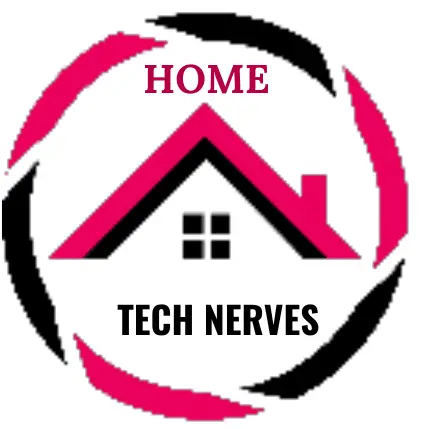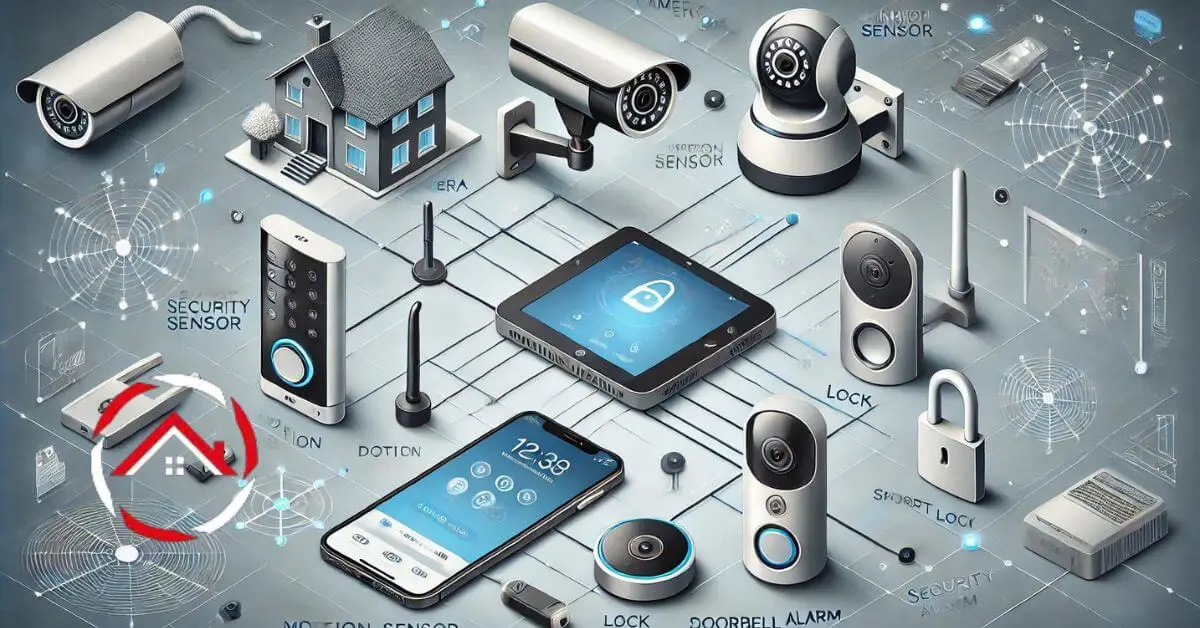Choosing the right home security system can be overwhelming. With so many options available, it’s easy to get lost in the details. But don’t worry!
Understanding the essential features can make the process much simpler. Look for a system that includes security cameras, motion sensors, and smart locks.
These provide a strong foundation. Consider extras like mobile app integration, environmental sensors, and professional monitoring for added safety.
In this post, I’ll explore the top home security system features to look for while making a purchase.
Think about what works best for your home and lifestyle. By focusing on these key features, you’ll ensure your home is protected and your peace of mind is secured.
Table of Contents
Core Components – Home Security System Features to Look For
When building an effective home security system, it’s important to understand the core components that make up a robust and reliable setup.
Each component has a unique role in securing your home and deterring potential threats. Below are the key elements you should consider.
A. Control Panel/Hub
- Central Unit: The control panel serves as the brain of the security system, connecting and managing all security devices.
- Compatibility: Ensures that various devices such as cameras, sensors, and alarms can work together seamlessly.
- Smart Home Integration: Should be compatible with smart home systems like Alexa, Google Home, and Apple HomeKit.
- User Interface: Easy-to-use interface for arming/disarming and configuring settings.
- Remote Access: Allows for control and monitoring through a smartphone app.
B. Security Cameras
- Types:
- Indoor Cameras: Monitor interior spaces, ideal for keeping an eye on living areas or hallways.
- Outdoor Cameras: Built to withstand weather conditions, they monitor driveways, gardens, and entry points.
- Doorbell Cameras: Provide a view of who’s at your doorstep and enable two-way communication.
- Key Features:
- High-Resolution Video: Clear footage that helps identify people and events.
- Night Vision: Provides visibility in low-light conditions.
- Motion Detection: Detects and alerts when there is movement in the camera’s field of view.
- Cloud Storage: Saves video footage for later viewing and sharing.
- Two-Way Audio: Enables direct communication with visitors or potential intruders.
C. Motion Sensors
- Types:
- Infrared Sensors: Detects movement based on body heat.
- Microwave Sensors: Emits waves and measures reflection to detect motion.
- Placement and Coverage:
- Best placed at entry points, hallways, and rooms with high traffic.
- Can be configured to avoid triggering false alarms from pets.
D. Door and Window Sensors
- Functionality:
- Alerts when doors or windows are opened or tampered with.
- Acts as a first line of defense against intruders.
- Integration:
- Triggers other devices like cameras or alarms when a door or window is breached.
- Can be used to automatically activate smart locks or lighting.
E. Alarm Systems and Sirens
- Key Features:
- Decibel Level: Loud enough to alert occupants and deter intruders.
- Duration and Tone: Customizable tones and durations to match specific situations.
- Integration: Syncs with other security devices to create a cohesive system response.
- Role in Deterrence:
- Scares off intruders by drawing attention.
- Notifies authorities or neighbors during an emergency.
Advanced Security Features
Modern home security systems go beyond traditional components like cameras and alarms.
Advanced features offer improved functionality, convenience, and a higher level of protection.
Below are some advanced elements to consider for a comprehensive security setup.
A. Smart Locks
- Features:
- Remote locking and unlocking from a mobile app or smart device.
- Provides entry logs to track who enters and exits your home.
- Seamless integration with other smart home systems, like Alexa or Google Home.
- Benefits:
- Enhanced control over who has access to your home, even when you’re away.
- Convenience of granting temporary access to guests or service personnel.
B. Environmental Sensors
- Types:
- Smoke Detectors: Alerts when smoke is detected, preventing fire hazards.
- Carbon Monoxide Detectors: Monitors dangerous levels of carbon monoxide in the air.
- Water Leak Sensors: Detects moisture or leaks to prevent water damage.
- Functionality:
- Protects your home from environmental threats like fires, gas leaks, or flooding.
- Sends alerts to your phone or triggers alarms when specific thresholds are breached.
C. Glass Break Sensors
- Functionality:
- Detects the unique sound frequency of breaking glass, alerting you to forced entry attempts.
- Reduces the chances of false alarms from other noises.
- Placement:
- Ideally positioned near large windows, sliding glass doors, or glass-panel entryways.
- Provides coverage in areas not monitored by door and window sensors.
D. Smart Doorbells
- Features:
- Equipped with a camera for monitoring visitors at your door.
- Two-way communication allows you to speak with guests or delivery personnel remotely.
- Motion detection triggers alerts even before someone rings the bell.
- Role:
- Helps prevent package theft by keeping an eye on deliveries.
- Screens visitors, providing an additional layer of security.
E. Video Doorbell
- Features:
- Real-time video streaming so you can see who’s at your door anytime.
- High-definition video recording with cloud storage options for reviewing past footage.
- Integration:
- Syncs with mobile apps, providing instant alerts and remote communication.
- Can connect with smart locks for controlling access without opening the door.
Integration and Automation Features
Integration and automation are crucial for maximizing the convenience and efficiency of your home security system.
With these features, you can seamlessly manage and control your system, making your home not just safer, but smarter.
Below are the key integration and automation features to look for.
A. Mobile App Integration
- Features:
- Remote Access: Control and monitor your security system from anywhere using your smartphone.
- Real-Time Notifications: Receive instant alerts for any security event, such as motion detection or door/window breaches.
- Video Streaming: View live feeds from your security cameras or doorbells directly on your phone.
- Device Control: Arm or disarm the system, lock/unlock doors, and adjust settings remotely.
- Compatibility:
- Works with both Android and iOS platforms.
- Integrates with smart home systems like Alexa, Google Home, and Apple HomeKit for unified control.
B. Home Automation Compatibility
- Integration with Smart Devices:
- Connects with smart lighting, thermostats, and other devices to enhance security and energy efficiency.
- For example, turning lights on automatically when motion is detected, or adjusting the thermostat when the system is armed.
- Creating Automated Routines:
- Set up routines like “Away Mode” to lock all doors, turn off lights, and arm the security system when leaving home.
- Customizable routines can be designed based on time, day, or specific triggers.
C. Voice Control
- Compatibility:
- Works with popular virtual assistants like Amazon Alexa and Google Assistant.
- Voice commands can be used to arm/disarm the system, lock/unlock doors, view camera feeds, and more.
- Control Over Specific Features:
- Use voice commands to activate specific actions, such as “Alexa, show me the front door camera,” or “Hey Google, turn off the alarm.”
- Provides hands-free convenience, especially useful when multitasking or in emergency situations.
Monitoring Options
Choosing the right monitoring option for your home security system is essential to ensure timely responses during emergencies.
Each option provides varying levels of service, control, and cost. Below are the primary monitoring options to consider when selecting a security system.
A. Professional Monitoring
- 24/7 Service:
- A dedicated team monitors your home around the clock.
- They contact emergency services (police, fire department) if a security breach or hazard is detected.
- Immediate Response:
- In case of an alert, professional monitoring ensures a quick response, even if you’re unavailable.
- Subscription Models:
- Typically requires a monthly fee, which may vary depending on the level of service and included features.
- Often includes added benefits like cloud storage and extended warranties.
B. Self-Monitoring
- Direct Notifications:
- Alerts and notifications are sent directly to your mobile device when a security event occurs.
- Provides real-time information without involving a third-party service.
- Advantages:
- Lower Cost: No monthly fees, making it an affordable option.
- Complete Control: You decide how to respond to alerts based on your preferences and situation.
- Flexibility: Adjust settings and monitor your home on your own terms.
- Limitations:
- Requires constant attention, as missed alerts could delay response to emergencies.
C. Hybrid Monitoring
- Combination Approach:
- Offers professional monitoring during specific hours (e.g., nights and weekends) and self-monitoring at other times.
- Provides a balance between cost and security.
- Benefits:
- Flexibility: Customize the level of monitoring based on your schedule and lifestyle.
- Cost-Effectiveness: Lower fees compared to full-time professional monitoring, with added peace of mind.
- Ideal For:
- Individuals who want professional support during high-risk periods while maintaining personal control during others.
Installation Options
Selecting the right installation method for your home security system can impact its effectiveness and ease of use. You can choose between do-it-yourself (DIY) installation or opting for professional setup, depending on your needs and preferences. Here’s a breakdown of the two primary installation options.
A. DIY Installation
- Benefits:
- Cost Savings: Eliminates the expense of hiring professionals, reducing overall system costs.
- Flexibility: You can install the system at your own pace, with no need to coordinate with external technicians.
- Ease of Installation: Modern systems often come with easy-to-follow instructions, making setup quick and straightforward.
- Limitations:
- Improper Setup Risk: Lack of professional expertise can lead to incorrect placement or system configurations.
- Coverage Gaps: Inadequate knowledge about sensor and camera placement may leave areas unprotected.
B. Professional Installation
- Benefits:
- Expertise: Professionals ensure that devices are placed and configured for optimal performance and coverage.
- System Optimization: Technicians test the entire system to ensure it functions as intended, minimizing the chance of errors.
- Peace of Mind: No need to worry about complicated wiring or connectivity issues.
- Limitations:
- Higher Cost: Installation fees add to the overall cost of your security system.
- Scheduling Dependency: Requires scheduling an appointment, which can sometimes delay the setup process.
System Reliability and Support
Reliability and support are crucial aspects of a home security system. A reliable system operates seamlessly under various conditions, while excellent customer support ensures that you can resolve any issues quickly. Below are the key components to consider for system reliability and support.
A. Battery Backup
- Importance:
- Ensures the security system continues to operate during power outages or electrical failures.
- Keeps sensors, cameras, and alarms functional, providing uninterrupted protection.
- Types of Backup:
- Battery Duration: Systems may come with backup batteries lasting anywhere from a few hours to several days, depending on the model.
- Swappable Battery Options: Some systems allow for easily swappable batteries, ensuring extended power during prolonged outages.
B. Customer Support and Warranty
- 24/7 Support Availability:
- Round-the-clock technical support to assist with system troubleshooting and maintenance.
- Quick resolution of technical issues or device malfunctions.
- System Warranty:
- Comprehensive warranties cover defects, faulty devices, or installation issues.
- Often includes free replacement or repair services during the warranty period.
- User Reviews and Ratings:
- Check user reviews and ratings to gauge the quality and responsiveness of the support team.
- Positive customer feedback indicates reliable service, which is essential for a hassle-free experience.
Budget and Cost Considerations
Understanding the costs involved in setting up and maintaining a home security system is crucial for making an informed decision.
It’s important to consider both the initial setup expenses and the ongoing costs to find a system that fits your budget.
Here are the key financial aspects to keep in mind.
A. Initial Setup Cost
- Price of Devices:
- The cost of individual components such as cameras, sensors, control panels, and alarms can vary widely depending on their features and quality.
- All-in-one packages may offer better value compared to purchasing devices separately.
- Professional Installation:
- If you opt for professional installation, factor in the technician’s fees, which can range from a flat fee to hourly charges based on the complexity of the setup.
- DIY installation can save on these costs, but ensure you have the expertise to install it properly.
- Additional Equipment:
- Extra sensors, cameras, or smart home devices can increase the initial setup cost.
- Consider whether these extras are necessary for your home’s layout and specific security needs.
- Value Comparison:
- Compare different systems not just based on price, but also on the features included. A higher upfront cost may offer better long-term value if the system provides extensive coverage and advanced capabilities.
B. Ongoing Costs
- Subscription Fees:
- Monthly or annual fees for professional monitoring services ensure your home is monitored 24/7. Plans may range from basic monitoring to premium packages with added features.
- Subscription costs for cloud storage enable you to access video recordings and event history remotely.
- Optional Features:
- Adding more cameras, environmental sensors, or automation devices can increase ongoing costs.
- Premium features like extended cloud storage, advanced analytics (e.g., facial recognition), or enhanced support services may also require additional fees.
By understanding these budget considerations, you can choose a security system that provides the best balance of cost and functionality for your home.
Wrap Up
When choosing a home security system, focus on essential features like security cameras, motion sensors, and smart locks.
Consider advanced options such as smart integration and professional monitoring based on your specific needs.
Balance your security requirements with your budget, ensuring you get the best value without overspending.
Future scalability is also key—opt for systems that can grow with your needs, adding devices or services as your security concerns evolve.
Frequently Asked Questions
What are the essential features of a home security system?
Essential features include 24/7 monitoring, motion detection, video surveillance, remote access, smart home integration, and a loud alarm. These features provide comprehensive protection and ensure you can monitor your home from anywhere, enhancing your overall security.
How important is video surveillance in a home security system?
Video surveillance is crucial as it allows you to monitor your property in real time. It acts as a deterrent to potential intruders and provides valuable evidence in case of incidents. High-definition cameras with night vision enhance visibility and security.
Can I integrate smart home devices with my security system?
Yes, many modern home security systems support integration with smart home devices like smart locks, lights, and thermostats. This integration allows for remote control and automation, enhancing your security and convenience while making it easier to manage your home environment.
What should I consider for outdoor security features?
For outdoor security, consider motion-activated lights, weatherproof cameras, and perimeter sensors. Ensure cameras have wide angles and night vision capabilities. These features help deter intruders, improve visibility, and ensure comprehensive protection around your home’s exterior.


